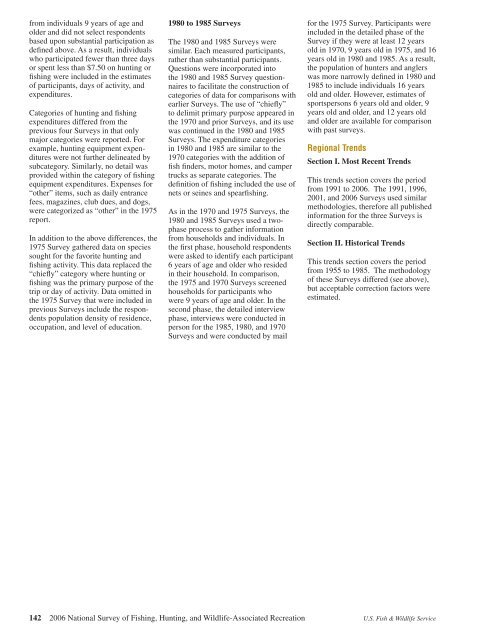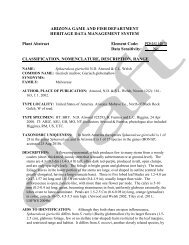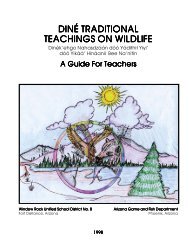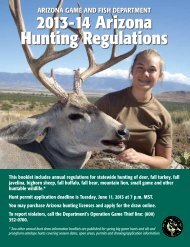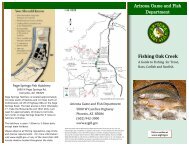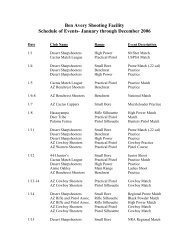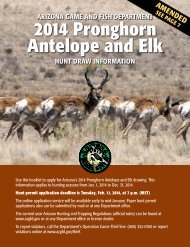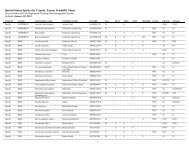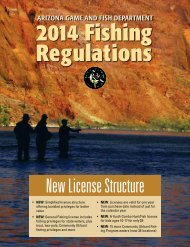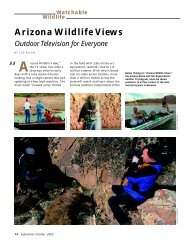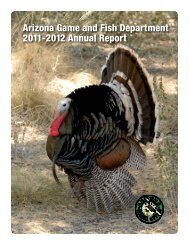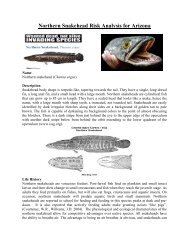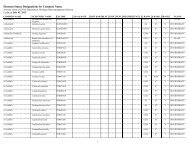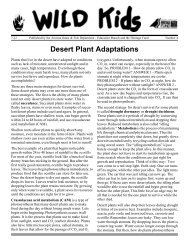2006 National Survey of Fishing, Hunting, and Wildlife-Associated ...
2006 National Survey of Fishing, Hunting, and Wildlife-Associated ...
2006 National Survey of Fishing, Hunting, and Wildlife-Associated ...
You also want an ePaper? Increase the reach of your titles
YUMPU automatically turns print PDFs into web optimized ePapers that Google loves.
from individuals 9 years <strong>of</strong> age <strong>and</strong><br />
older <strong>and</strong> did not select respondents<br />
based upon substantial participation as<br />
defined above. As a result, individuals<br />
who participated fewer than three days<br />
or spent less than $7.50 on hunting or<br />
fishing were included in the estimates<br />
<strong>of</strong> participants, days <strong>of</strong> activity, <strong>and</strong><br />
expenditures.<br />
Categories <strong>of</strong> hunting <strong>and</strong> fishing<br />
expenditures differed from the<br />
previous four <strong>Survey</strong>s in that only<br />
major categories were reported. For<br />
example, hunting equipment expenditures<br />
were not further delineated by<br />
subcategory. Similarly, no detail was<br />
provided within the category <strong>of</strong> fishing<br />
equipment expenditures. Expenses for<br />
“other” items, such as daily entrance<br />
fees, magazines, club dues, <strong>and</strong> dogs,<br />
were categorized as “other” in the 1975<br />
report.<br />
In addition to the above differences, the<br />
1975 <strong>Survey</strong> gathered data on species<br />
sought for the favorite hunting <strong>and</strong><br />
fishing activity. This data replaced the<br />
“chiefly” category where hunting or<br />
fishing was the primary purpose <strong>of</strong> the<br />
trip or day <strong>of</strong> activity. Data omitted in<br />
the 1975 <strong>Survey</strong> that were included in<br />
previous <strong>Survey</strong>s include the respondents<br />
population density <strong>of</strong> residence,<br />
occupation, <strong>and</strong> level <strong>of</strong> education.<br />
1980 to 1985 <strong>Survey</strong>s<br />
The 1980 <strong>and</strong> 1985 <strong>Survey</strong>s were<br />
similar. Each measured participants,<br />
rather than substantial participants.<br />
Questions were incorporated into<br />
the 1980 <strong>and</strong> 1985 <strong>Survey</strong> questionnaires<br />
to facilitate the construction <strong>of</strong><br />
categories <strong>of</strong> data for comparisons with<br />
earlier <strong>Survey</strong>s. The use <strong>of</strong> “chiefly”<br />
to delimit primary purpose appeared in<br />
the 1970 <strong>and</strong> prior <strong>Survey</strong>s, <strong>and</strong> its use<br />
was continued in the 1980 <strong>and</strong> 1985<br />
<strong>Survey</strong>s. The expenditure categories<br />
in 1980 <strong>and</strong> 1985 are similar to the<br />
1970 categories with the addition <strong>of</strong><br />
fish finders, motor homes, <strong>and</strong> camper<br />
trucks as separate categories. The<br />
definition <strong>of</strong> fishing included the use <strong>of</strong><br />
nets or seines <strong>and</strong> spearfishing.<br />
As in the 1970 <strong>and</strong> 1975 <strong>Survey</strong>s, the<br />
1980 <strong>and</strong> 1985 <strong>Survey</strong>s used a twophase<br />
process to gather information<br />
from households <strong>and</strong> individuals. In<br />
the first phase, household respondents<br />
were asked to identify each participant<br />
6 years <strong>of</strong> age <strong>and</strong> older who resided<br />
in their household. In comparison,<br />
the 1975 <strong>and</strong> 1970 <strong>Survey</strong>s screened<br />
households for participants who<br />
were 9 years <strong>of</strong> age <strong>and</strong> older. In the<br />
second phase, the detailed interview<br />
phase, interviews were conducted in<br />
person for the 1985, 1980, <strong>and</strong> 1970<br />
<strong>Survey</strong>s <strong>and</strong> were conducted by mail<br />
for the 1975 <strong>Survey</strong>. Participants were<br />
included in the detailed phase <strong>of</strong> the<br />
<strong>Survey</strong> if they were at least 12 years<br />
old in 1970, 9 years old in 1975, <strong>and</strong> 16<br />
years old in 1980 <strong>and</strong> 1985. As a result,<br />
the population <strong>of</strong> hunters <strong>and</strong> anglers<br />
was more narrowly defined in 1980 <strong>and</strong><br />
1985 to include individuals 16 years<br />
old <strong>and</strong> older. However, estimates <strong>of</strong><br />
sportspersons 6 years old <strong>and</strong> older, 9<br />
years old <strong>and</strong> older, <strong>and</strong> 12 years old<br />
<strong>and</strong> older are available for comparison<br />
with past surveys.<br />
Regional Trends<br />
Section I. Most Recent Trends<br />
This trends section covers the period<br />
from 1991 to <strong>2006</strong>. The 1991, 1996,<br />
2001, <strong>and</strong> <strong>2006</strong> <strong>Survey</strong>s used similar<br />
methodologies, therefore all published<br />
information for the three <strong>Survey</strong>s is<br />
directly comparable.<br />
Section II. Historical Trends<br />
This trends section covers the period<br />
from 1955 to 1985. The methodology<br />
<strong>of</strong> these <strong>Survey</strong>s differed (see above),<br />
but acceptable correction factors were<br />
estimated.<br />
142 <strong>2006</strong> <strong>National</strong> <strong>Survey</strong> <strong>of</strong> <strong>Fishing</strong>, <strong>Hunting</strong>, <strong>and</strong> <strong>Wildlife</strong>-<strong>Associated</strong> Recreation U.S. Fish & <strong>Wildlife</strong> Service


